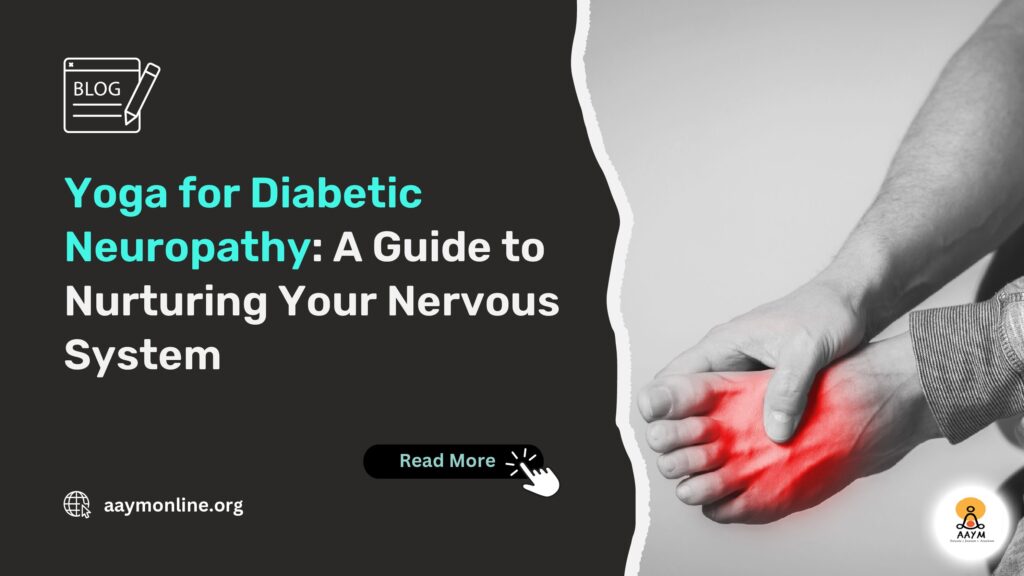Embracing Yoga for Nurturing Diabetic Nerves Navigating through the intricate challenges posed by diabetic neuropathy can often be a daunting journey. This condition, characterized by nerve damage resulting from prolonged high blood sugar levels, brings forth numerous physical and emotional challenges for individuals. However, amidst these challenges, yoga emerges as a gentle, yet potent ally, offering a sanctuary of relief and rejuvenation for the nerves. The ancient practice of yoga, with its harmonious blend of physical postures, mindful breathing, and meditation, provides a holistic platform to nurture not just the physical body, but also the mind and spirit. Engaging in yoga practices can potentially alleviate the symptoms of diabetic neuropathy, offering a pathway towards enhanced well-being and improved quality of life. As we delve deeper into this guide, we shall explore the myriad ways through which yoga can become a steadfast companion in your journey towards managing diabetic neuropathy effectively. Unveiling the Intricacies of Diabetic Neuropathy Diabetic neuropathy, a prevalent complication of diabetes, predominantly impacts the nervous system, manifesting in varied symptoms such as numbness, tingling, and pain in the extremities. Understanding the intricacies of diabetic neuropathy involves exploring its types, each characterized by its unique set of symptoms and impact areas. From peripheral neuropathy, which is the most common type affecting feet and legs, to autonomic neuropathy impacting the internal organs, each variant of diabetic neuropathy presents its own set of challenges and management strategies. Lifestyle implications, such as the necessity to adopt specific foot care routines or dietary adjustments, often become integral to managing this ailment. As we navigate through the subsequent sections, we shall delve into how yoga, with its multifaceted benefits, can be seamlessly woven into the lifestyle adaptations required for managing diabetic neuropathy, providing a holistic approach that nurtures the nervous system and promotes overall well-being. The Healing Touch of Yoga on Nervous System Embarking on a journey through yoga unveils a realm where the nervous system finds a gentle, nurturing environment to heal and rejuvenate. Yoga, in its essence, is a practice that transcends mere physicality, weaving through the realms of mental and emotional well-being. The postures, or asanas, while beneficial for physical health, also extend their impact to the nervous system, fostering a state of balance and tranquility. Mindful breathing practices, or pranayama, in yoga, serve as a bridge, connecting the mind and body, and facilitating a state of relaxed alertness. Furthermore, meditation, a key component of yoga, provides a sanctuary for the mind, alleviating stress, and promoting mental well-being. As we explore the myriad facets of yoga, it becomes evident that its impact is not just physical but permeates through every layer of our being, offering a holistic approach to managing health conditions, such as diabetic neuropathy, and positioning Yoga for Diabetic Neuropathy as a viable, holistic management strategy. Yoga Asanas: A Soothing Therapy for Diabetic Neuropathy Diving deeper into the world of yoga, we encounter various yoga asanas or postures, each offering its unique blend of physical and mental benefits. When it comes to managing diabetic neuropathy, certain yoga asanas stand out, providing not just physical relief but also enhancing nerve function. For instance, postures that focus on leg engagement and balance can potentially improve nerve responses and alleviate symptoms in the lower extremities, a common concern in diabetic neuropathy. Similarly, asanas that promote relaxation and stress reduction can be particularly beneficial, considering the impact of stress on blood sugar levels and overall neuropathy management. As we explore these yoga asanas, it’s imperative to approach them with mindfulness and awareness, ensuring that the practice is adapted to the individual’s unique needs and challenges posed by diabetic neuropathy. In the subsequent sections, we shall delve into specific asanas, exploring their benefits and adaptations, providing a comprehensive guide to integrating Yoga for Diabetic Neuropathy into your routine for managing this condition effectively. Scientific Backing: Yoga and Diabetic Neuropathy Research Insights Navigating through the scientific landscape, numerous studies and research findings have underscored the potential of Yoga for Diabetic Neuropathy. A review article in the International Journal of Alternative and Complementary Medicine meticulously explores the role of yoga therapy in managing diabetic neuropathy. The study, which utilized search terms related to Autonomic Diabetic Neuropathy and Yoga, and Alternative Therapy across various data repositories like PubMed and Google Scholar, concluded that while yoga showcases clinical significance in managing Diabetic Neuropathy, there is a palpable need for more quality studies in this domain. The researchers advocate for more robust evidence through Randomized Controlled Trials conducted on larger sample sizes to further validate the efficacy of yoga in diabetic neuropathy management. Moreover, a systematic review in the Journal of Diabetes Research evaluates the impact of yoga-based programs on health outcomes pertinent to DM2 management. The findings illuminate that yogic practices may foster significant improvements in various indices crucial for DM2 management, including glycemic control, lipid levels, and body composition, thereby reinforcing the potential role of yoga in managing diabetic conditions. Crafting a Yoga Routine for Diabetic Neuropathy Management Embarking on a journey with Yoga for Diabetic Neuropathy involves crafting a yoga routine that is not only therapeutic but also adaptable to the unique needs and challenges of individuals with diabetic neuropathy. Creating a yoga routine tailored for diabetic neuropathy management involves a mindful blend of asanas, pranayama, and meditation, each chosen to cater to the specific needs and safety of the practitioner. Consistency, progression, and mindfulness become the pillars upon which this yoga routine stands, ensuring that the practice evolves in harmony with the practitioner’s journey through diabetic neuropathy management. A review article on Diabetes Mellitus from IAMJ emphasizes the pivotal role of exercise and lifestyle modifications, which include a regular regimen of exercise, yoga-asana, pranayama, and adherence to regular food & sleep patterns, in managing diabetes. This underscores the importance of integrating yoga seamlessly into daily life, ensuring that it becomes a sustainable and nurturing practice that supports individuals in managing diabetic neuropathy effectively. Precautions and Guidelines: Practicing Yoga Safely with Diabetic Neuropathy Embarking on










